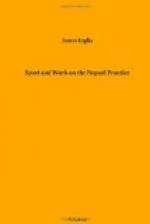Another rope acts as a crupper behind, being passed through rings in the terminal frame-work of the howdah, and under the elephant’s tail; it frequently causes painful sores there, and some drivers give it a hitch round the tail, in the same way as you would hitch it round a post. Another steadying rope goes round the elephant’s breast, like a chest-band. ‘A merciful man is merciful to his beast.’ You should always, therefore, have a sheet of soft well oiled leather to go between the chest and belly ropes and the elephant’s hide; this prevents chafing, and is a great relief to the poor old hathi, as they call the elephant. Hatnee is the female elephant. Duntar is a fellow with large tusks, and mukna is an elephant with small downward growing tusks.
Many of the old fashioned howdahs are far too heavy; a firm, strong howdah should not weigh more than 28 lbs. In most of the old fashioned ones, there is a seat for an attendant. If your attendant be a Mussulman, he hurries down as soon as you shoot a deer, to cut its throat. The Mohammedan religion enjoins a variety of rules on its professors in regard to the slaying of animals for food. Chief of these is a prohibition, against eating the flesh of an animal that has died a natural death; the throat of every animal intended to be eaten should be cut, and at the moment of applying the knife, Bismillah should be said, that is, ‘In the name of God.’ If therefore your mahout, or attendant, belong to the religion of the Koran, he will hurry down to cut the throat of a wounded deer if possible before life is extinct; if it be already dead, he will leave it alone for the Hindoos, who have no such scruples.
A number of moosahurs, banturs, gwallas, and other idlers, from the jungle villages, generally follow in the wake of the line. If you shoot many pigs, they carry off the dead bodies, and hold high carnival in their homes in the evening. To see them rush on a slain buffalo, and hack it to pieces, is a curious sight; they fight for pieces of flesh like so many vultures. Sportsmen generally content themselves with the head of a buffalo, but not a scrap of the carcase is ever wasted. The natives are attracted to the spot, like ants to a heap of grain, or wasps to an old sugar barrel; they seem to spring out of the earth, so rapidly do they make their appearance. If you were to kill a dozen buffaloes, I believe all the flesh would be taken away to the neighbouring villages within an hour.
This appearance of men in the jungles is wonderful. You may think yourself in the centre of a vast wilderness, not a sign of human habitation for miles around; on all sides stretches a vast ocean of grass, the resort of ferocious wild animals, seemingly untrodden by a human foot. You shoot a deer, a pig, or other animal whose flesh is fit for food; the man behind you gives a cry, and in ten minutes you will have a group of brawny young fellows around your elephant, eager to carry away the game. The way these natives thread the dense jungle is to me a wonder; they seem to know every devious path and hidden recess, and they traverse the most gloomy and dangerous solitudes without betraying the slightest apprehension.




